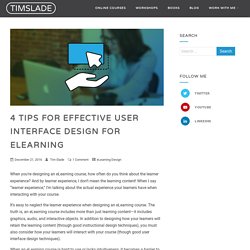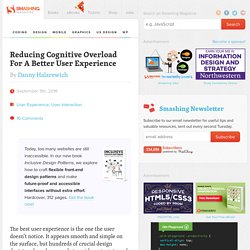

10 Principles of Learning Experience Design. ELC 063: The Evolution To Learning Experience Design. Empathy Maps: A Tool for Learning Experience Design. Manifesto - Learning Experience Design. 4 Tips for Effective User Interface Design for eLearning. When you’re designing an eLearning course, how often do you think about the learner experience?

And by learner experience, I don’t mean the learning content! When I say “learner experience,” I’m talking about the actual experience your learners have when interacting with your course. It’s easy to neglect the learner experience when designing an eLearning course. The truth is, an eLearning course includes more than just learning content—it includes graphics, audio, and interactive objects. Interaction Design Foundation (IxDF) Design Thinking: Level-Up the Learner Experience. Two years ago I was at a CLO conference in Austin, Texas.

The keynote speaker asked a question that gave me pause then – and continues to drive me now. He asked, “Is the 45-minute course you created a good use of 45 minutes of the learner’s life? Because those are 45 minutes of time that individual does not get back.” “Learner experience” (LX) is an emerging buzz term that originated from the software world, which focuses on “UX” or user experience. The question the speaker posed at the conference goes to the heart of what an effective user experience (aka learner experience) delivers to someone, which is three things: 1. Typically, UX refers to the experience of using software. So what happened? Somewhere in the actual practice of instructional design, we throw this equation out of balance.
The result, too often, is solutions that are out of balance. How to Design Great Learning Experiences Instead of Just Delivering Content. Let’s pretend you’re going on vacation with a friend we’ll call Suzy.

You tell Suzy you love vacation planning and you’ll take care of everything. Suzy is a busy woman and says “Great!”. You agree on the week to go, a climate, and a budget, and you immerse yourself in planning. You know Suzy enjoys being active, how much she’s is willing to spend, and that you both want to go somewhere hot. So you find a perfect hiking trip for the two of you.
You let Suzy know you have a terrific active vacation planned and what time to meet you at the airport. Both your vacations are ruined. How to Take a Learning Experience From Miserable to Memorable. Imagine you own a travel business.

You decide to specialize in trips to Europe. It’s up to you to define the itinerary and make all decisions regarding what a group will do. Now imagine two groups of travelers and two trip purposes. One trip is for educational purposes. This trip is targeted toward low-income youth ages 16-18 who have never even flown on a plane before. Why You Need a Learning Journey Map. What do instructional designers, training managers/directors, and CLOs all have in common?

These roles all (should) care intensely about creating learning solutions that deliver operational results for a business. Do you want the learning solutions you build or buy to deliver meaningful business results? If so, you’ll need to look outside the traditional box that “training” sits inside. For example, software developers and product managers obsess over the user experience (UX) of what they create. It drives almost every decision, and the success or failure of their efforts depends on having a great UX. It’s way past time for learning professionals to do the same for the learner experience (LX). The Rise of Design Thinking. What Can Video Games Teach Us About Instructional Design? When I was a kid, I used to spend hours playing Tetris.

I would zone out everything else and hit a state of hyperfocus. I was fully engaged. I could spend hours playing Tetris. Over the years, the trending games have changed. I may or may not have created my own fair share of Sonic the Hedgehog fan art when I was in middle school. It has me wondering . . . What can we learn from video games?
If you enjoy this blog but you’d like to listen to it on the go, just click on the audio below or subscribe via iTunes/Apple Podcasts (ideal for iOS users) or Google Play and Stitcher (ideal for Android users). Check out the following video below about the six things video games can teach us about instructional design and student engagement: #1: Intrinsic motivation Video games are engaging because they are fun. User Interface Design: 3 Things E-Learning Designers Need to Know. How to Design a Better Learner Experience. Re-design learning. John Spencer - The Creative Classroom. 7 Ways UX Design Theory Transformed My Approach to Course Design. 7 Ways UX Design Theory Transformed My Approach to Course Design.
Reducing Cognitive Overload For A Better User Experience. Advertisement Today, too many websites are still inaccessible.

In our new book Inclusive Design Patterns, we explore how to craft flexible front-end design patterns and make future-proof and accessible interfaces without extra effort. Hardcover, 312 pages. Get the book now! The best user experience is the one the user doesn’t notice. If the user experience design does what it’s supposed to do, the user won’t notice any of the work that went into it. “Getting in the way of a speeding freight train usually doesn’t end well. After all, consider the alternative. Further Reading on SmashingMag: Link This excessive thinking is called cognitive overload, and here we’ll explain how you can avoid it. The Scientific Roots Of Cognitive Overload Link Cognitive load refers to the total amount of information your working memory can handle.
But what does that mean, really? John Sweller and Cognitive Load Theory Link.